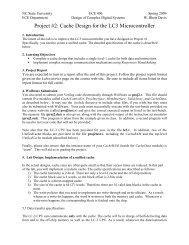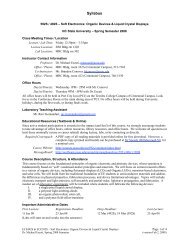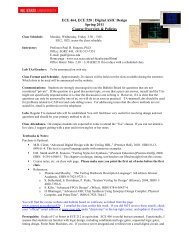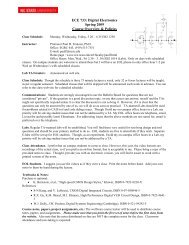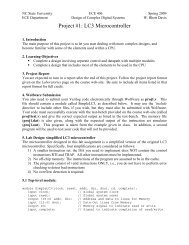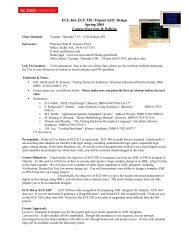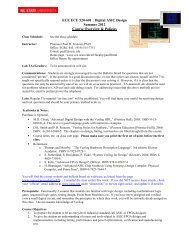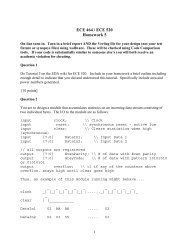Project One Report
Project One Report
Project One Report
Create successful ePaper yourself
Turn your PDF publications into a flip-book with our unique Google optimized e-Paper software.
ECE 406: <strong>Project</strong> <strong>One</strong> <strong>Report</strong> Barwick<br />
Each of these modules were outlined with specific requirements. Once these<br />
requirements were defined, they were implemented as well as tested individually.<br />
For example, the Controller block, which keeps track of the different states of the<br />
system, was first outlined using a state diagram and then implemented in Verilog<br />
using a case statement and register.<br />
III. TESTING AND DEBUGGING<br />
Perhaps the most difficult part of this project was testing and debugging.<br />
After each module was designed, a test bench was written for that module to<br />
determine if the module met the requirements detailed in the design process.<br />
Testing each individual module first rather than waiting to test the entire system<br />
proved to be extremely helpful. It caught obvious bugs and prevented me from<br />
feeling overwhelmed. However, it turned out that testing the modules individually<br />
does not guarantee that the over system will function properly. Once the modules<br />
were connected together, there were several issues some of which have been outlined<br />
below.<br />
a. Improper connections<br />
When the microprocessor was first compiled, several errors were received<br />
stemming from the top level module. The specific error was:<br />
ncelab: *W,CUVMPW (./proj1.v,30|74): port sizes differ<br />
in port connection.<br />
The error resulted from not explicitly stating multiple wire labels that<br />
connect each module. If a single wire connects the modules, such as the “clock”,<br />
it does not need to be defined as a wire. However, if it is multiple wires, such as<br />
“D_Data”, the label needs to be defined (ex. “wire [47:0] D_Data;”). I defined<br />
the wires needed wires explicitly and the program complied without error.<br />
b. Bad Fetch Module<br />
After the system successfully compiled, the anomalous behavior shown in<br />
figure two was observed. The system did not seem to be getting the proper<br />
memory address, which is determined by the fetch module. The schematic for<br />
the fetch module was reevaluated and it was determined that the “pc” signal was<br />
not being set properly. During certain states the “pc” signal from the fetch<br />
module needed to be high impedance due to a shared bus. A simple change in the<br />
code within the fetch module fixed this. This obvious bug should have been<br />
caught during the individual module testing and may have gotten through due to<br />
poor testing.<br />
Page | 2



